Entomology, Ornithology & Herpetology: Current Research
Open Access
ISSN: 2161-0983
ISSN: 2161-0983
Research Article - (2022)Volume 11, Issue 1
Tomato (Solanum lycopersicum L.) is a main horticultural crop for income and nutrition to urban and peri-urban communities. Invasion by Tuta absoluta has caused high damage and loss threatening livelihood of farmers in Tanzania. Host resistance mechanism of tomato landraces own unique physiological and biochemical traits that can fight against pest attack. This study screened twenty-one landrace varieties for their vigorous and resistance against T. absoluta in three major tomatoes growing zones of Tanzania. Findings showed that landraces had high growth rates resulting in many leaves per plant averaging 29.04 ± 1.12 compared to improved cultivar (Tengeru 97) that possessed 18.75 ± 0.62 leaves/plant. Landrace varieties yielded high tomato fruits averaging 18.82 ± 1.93 t/ha and 91.66% of marketable yield in contrast to improved variety that yielded 8.60 ± 3.50 t/ha and 19.73% of marketable yield in Southern of Tanzania. Again, tomato landraces lasted longer for 35.53 ± 1.81 days compared to Tengeru 97 (check) that lasted for 16.65 ± 0.36 days at room temperature 25 ± 0.9. These findings revealed that Tanzanian landraces reserve vigorous traits for yield and defence against pest, hence suggest the cultivation without fertilisation and pesticides for safe and sustainable production of tomato to improve income and health of farmers in Tanzania.
Host resistance; Organic farming; Pest control; Tomato landraces
Wild tomato varieties including landraces possess important traits compared to improved varieties for pests and diseases defence [1,2]. Mechanism of resistance is either by physical deterrent to pest or through secondary metabolites such as acyl sugars particularly the Zingiberene has been reported to kill various life stages of Tuta absoluta [3-5]. The physiology of wild tomato especially trichome protect it against invading pest [6]. It is also reported that the leaf surface of most wild accession affect oviposition and kill eggs or young larvae of T. absoluta [7]. This is because they embrace traits responsible for defence against sucking pests including aphids (Aphis gossypii) [8,9]. They also resist against several plant pathogens and diseases [10,11] including viruses that are more prominent on tomato and several Solanaceae’s crops [12,13]. Landraces have many advantages over improved cultivar as they strive under harsh environmental conditions such as drought, high salinity and heavy rains [14, 15]. They can be grown in limited nutrient soil and does not require fertilizer [16]. Studies have revealed that landrace accessions possess resistant trait against T. absoluta [17,18]. Despite merits of indigenous tomato, they are not accessible by farmers in agro-ecological zones of Tanzania due to low priority by farmers and breeders focusing on improved variety that are commercially available [19]. Cultivation and promotion of land races can save as antagonistic units of various insect pests challenges [20]. There is no study on resistant tomato varieties against T absoluta in Tanzania. However there is evidence that, tomato landraces could be source of resistance against pest in Tanzania [19]. Therefore, this study selected some landraces and screened for resistance against T absoluta in screen house and in field conditions in Tanzania.
Screening for resistant accessions against T. absoluta in screen house
Twenty-one tomato landraces Table 1 and Tengeru 97 (check) were sown separately in 66 well trays (two seeds were sown per hole) in sterile soil in which each tray contained a total of 132 seeds. Seedlings were raised in screen house (28.4 ± 2.1°C and 70% RH) and were watered once a day. Each accession was monitored for germination rate in which number of seedlings germinated, percentage of germination and germination duration were recorded. Seedlings were then thinned to one seedling two weeks after planting. Three weeks after transplanting, trays with all tomato accessions were transferred in closed transparent cages of about 6 x 4 x 3.5 cm length, width and height respectively. Then, 46 newly (2 days) emerged adults female T. absoluta were introduced and symptoms of infestation (mines/accession) were recorded up 7 days after inoculation of insect (Table 1).
| Genotype | No. of seeds germinated | Germination rate (%) | Germination time (days) | Number of mines/plants |
|---|---|---|---|---|
| BKB-22 | 124 | 93.939 | 5.42 ± 0.71 | 0.14 ± 0.01a |
| KGM-5 | 118 | 89.39 | 5.85 ± 0.33 | 0.5 ± 0.05a |
| HSK-43 | 124 | 93.939 | 6.11 ± 0.18 | 0.66 ± 0.10a |
| HSK-38 | 122 | 92.42 | 7.14 ± 0.67 | 0.66 ± 0.12a |
| Tengeru 97 | 114 | 86.36 | 8.19 ± 0.22 | 6.84 ± 0.03b |
| SGD-1 | 122 | 92.42 | 6.19 ± 0.30 | 4.28 ± 0.84b |
| HSK-29 | 114 | 86.363 | 6.22 ± 0.28 | 4.33 ± 0.54b |
| SGD-7 | 112 | 84.84 | 6.28 ± 0.26 | 4.57 ± 0.21b |
| HSK-39 | 124 | 93.93 | 6.33 ± 0.32 | 4.66 ± 0.18b |
| KGM-9 | 122 | 92.42 | 6.52 ± 0.22 | 4.71 ± 0.25b |
| BKB-1 | 118 | 89.39 | 6.52 ± 0.04 | 4.80 ± 0.58b |
| HSK-17 | 116 | 87.87 | 6.57 ± 0.24 | 4.85 ± 0.88b |
| HSK-18 | 114 | 86.36 | 6.70 ± 0.28 | 4.90 ± 0.29b |
| HSK-19 | 112 | 84.84 | 7.10 ± 0.03 | 4.95 ± 0.19b |
| SGD-2 | 120 | 90.9 | 7.04 ± 0.07 | 5.04 ± 0.75b |
| KGM-8 | 118 | 89.3 | 7.14 ± 0.35 | 5.09 ± 0.21b |
| HSK-31 | 114 | 86.36 | 7.23 ± 0.44 | 5.12 ± 0.22b |
| HSK-41 | 120 | 90.9 | 8.129 ± 0.46 | 5.07 ± 0.65b |
| HSK-1 | 122 | 92.42 | 8.14 ± 0.29 | 5.14 ± 0.91b |
| HSK-7 | 118 | 89.39 | 8.12 ± 0.74 | 5.14 ± 0.62b |
| HSK-09 | 116 | 87.87 | 8.22 ± 0.87 | 5.38 ± 0.85b |
| BKB-25 | 118 | 89.39 | 8.80 ± 0.32 | 5.31 ± 0.65b |
| p value | - | - | - | <0.0001 |
Table 1: Germination and growth rate of different tomato genotypes and their reaction to T. absoluta inoculation.
Evaluation of resistant accessions in field
Only accessions with lower number of mines (<2.0) per plant were selected for further screening for resistance in field. Thus, accessions; BKM-22, KGM-5, HSK-43, HSK 38 and improved variety (Tengeru 97) as check/control were used for this study. All seeds were sown in 72-pit (4 cm diameter) trays each filled with heat sterilized forest soil. Trays with seeds were sprinkled with water until wet and covered by white Agro net (0.4 m hole) (A to Z Company Ltd) maintained at the temperature of about 23.7 ± 2.4°C, 27.2 ± 1.3°C and 21.1 ± 2.2°C, in Northern, East-Central and Southern zone of Tanzania, respectively. Each tray was watered once a day during the evening for 21 days, and then seedlings were transferred to the field for transplanting and grown with no any synthetic input such as fertilizers or pesticides as described in literature [19]. Experimental plots were 20 m x 20 m each and seedlings were sown at the spacing of 60 cm and 40 cm between ridges and between plants, respectively. One day prior to transplanting, pits were prepared and watered using furrow irrigation scheme. One seedling was planted per hole of about 15 cm deep. Plots were weeded and pruned biweekly. All plots were watered after every three days by furrow irrigation until all plants were moist enough. Insect pests other than T. absoluta such as aphids (Aphis gossypii), mites (Aculops lycopersici), leaf miner (Lyriomyza sativae) and whitefly (Bemisia tabaci) were left uncontrolled in all plots to avoid interference with host plants.
Identification of morphological traits for resistance
Three weeks after transplanting in fields, number of leaves per plant was counted from fully expanded plant. Number of mines by T. absoluta larvae per plant in each tomato variety was recorded once per week for six weeks consecutively. Number and percentage of fruit damage per plant were calculated by subtracting marketable fruit from total yield per each accession in each location. In additional, harvest frequency per genotype was recorded to evaluate the accession with the shortest maturity rate.
Evaluation for post-harvest resilience
After harvest, 100 mature and firm fruits per genotype were exposed at room temperature (20°C and 75% RH) on benches to evaluate stability. Changes in shape, colour, spoilage and microbial contamination were observed and recorded daily until all fruits degraded in containers.
After fruit maturity number of fruits, weight of fruits, and percentage of damaged fruits were recorded separately after each harvest session whereas resilience and longevity of fruits was assessed after harvest. Number of leaves, number of T. absoluta mines per plant, number of fruits, weight of fruits, percentage of damaged fruits and fruit resilience were subjected to analysis of variance using SAS version 9.1, SAS Institute, Cary, USA. Data were tested for normality and homogeneity of variance before analysis. Differences observed between treatments were separated using the Tukey’s Honest Significant difference at 5% significance level.
Germination efficiency and susceptibility of tomato randraces to T. absoluta in screen house conditions
Results showed that landrace accessions had high germination number of up to 93.93% in accession BKB-22 within 5.42 ± 0.71 days whereas tomato cultivar Tengeru 97 germination reached 86.36% after 8.19 ± 0.22 days. Landrace accessions exhibited significant (p=<0.0001) resistance against T. absoluta larvae damage in with less than 5.38 ± 0.85 mines/accession compared with the control Tengeru 97 which had an average of 6.84 ± 0.03 mines/ plant (Table 1).
Growth rate of tomato landraces and resistance to T. absoluta in field conditions
For field trial, number of leaves/plant and height from seedling stage were determinant factors for growth and vigour. There was significant (p=<0.0001) variation in number of leaves/plants between tomato genotypes in which most landraces exhibited higher number of leaves/plants compared with the control cultivar. Accession HSK-38 possessed significantly the highest number of leaves that averaged 29.04 ± 1.12 leaves/plant than accession KGM- 5 and control where the later possessed few leaves averaging 18.75 ± 0.62 leaves/plant shown in Table 2.
| Tomato genotype | Number of leaves/plants | Number of T. absoluta mines/plant |
|---|---|---|
| BKB-22 | 26.36 ± 0.6ab | 9.46 ± 0.48b |
| Check | 18.75 ± 0.62b | 12.98 ± 0.98a |
| HSK-38 | 29.04 ± 1.12a | 7.94 ± 0.74b |
| HSK-43 | 27.31 ± 0.68ab | 9.01 ± 0.63b |
| KGM-5 | 25.37 ± 0.83ab | 9.37 ± 0.90b |
| p value | p=<0.0001 | p=<0.0001 |
Table 2: Growth rate and susceptibility of selected tomato genotypes to T. absoluta
The number of T. absoluta mines varied significantly (p=<0.0001) between tomato genotypes and most landraces exhibited few mines compared to the control that was more susceptive to larvae damage. Accession BKB-22 exhibited a significant low number of mines averaging 7.94 ± 0.74 per plant compared to the control that possessed higher number of mines averaging 12.98 ± 0.98 mines/ plant (Table 2).
The harvest frequency varied significantly (p=<0.0001) between tomato accessions and growing zones. Landrace accessions exhibited several harvest rates with short harvest intervals in which the East-central zone had more harvest frequency/week than Southern and Northern zones. In Central zone accession KGM- 5 had high harvest frequencies that reached 3.61 ± 0.32/week compared to accession BKB-22, HSK-43, HSK-38 and the control, where the later had only 0.5 ± 0.09 harvest/week. In Northern zone accession 3 had more harvest frequency which averaged 3.12 ± 0.35 than accession KGM-5, HSK-43, HSK-38 and check that had only 0.48 ± 0.08 frequency/week. The Southern zone exhibited the lowest fruit harvest frequency in which accession 2 had more harvest rate averaging 2.90 ± 0.21 in contrast to check which only 0.71 ± 0.10 harvest/week was achieved (Figure 1).
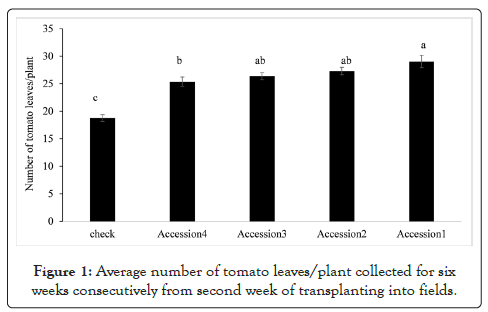
Figure 1: Average number of tomato leaves/plant collected for six weeks consecutively from second week of transplanting into fields.
Fruit damage by T. absoluta larvae was indicated by presence mines or pin holes on fruits. Variation of fruit damage/plant was significant (p=<0.0001) between tomato varieties and zone whereby an average of 118. 66 ± 21.18 g/plant was damaged by T. absoluta larvae in check plants than in landrace accession KGM-5, HSK-43, HSK-38, BKB-22 the later exhibiting only 22.69 ± 3.23 g/plant of damaged fruits in Northern zone, followed by Southern zone that averaged 66.44 ± 11.54 g/plant in check compared to accession 4 which was damaged by 29.85 ± 4.01 g/plant. The East-central zone exhibited the lowest damage with the check being most damaged with an average damage of 51.81 ± 5.00 g/plant compared to accession KGM-5, HSK-43, BKB-22 and HSK-38, where the later exhibited the lowest damage that averaged 34.62 ± 4.44 g/plant (Figure 2).
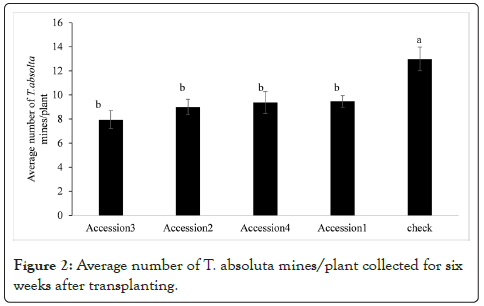
Figure 2: Average number of T. absoluta mines/plant collected for six weeks after transplanting.
Tomato yield varied significantly (p=<0.0001) between tomato accessions and zones in which landrace accessions yielded more fruits (t/ha) than check in all zones. The East-central zone yielded highest fruits than southern and northern where accession HSK-43 yielded the highest fruits that averaged 18.82 ± 2.67 t/ha compared to check that yielded 1.96 ± 1.08 t/ha. In the southern zone, the highest yield was achieved by accession BKB-22 that averaged 18.82 ± 1.93 t/ha in contrast to control that yielded the lowest fruits averaging 8.60 ± 3.50 t/ha. On other hand in the Northern zone accession 3 yielded the highest weight that averaged 17.15 ± 3.45 t/ ha than accession KGM-5, HSK-43, HSK-38 and the control that yielded the lowest fruits averaging 0.51 ± 0.08 t/ha (Figure 3).
Figure 3: Average number of damaged tomato leaves/plant recorded for six weeks after transplanting.
Percentage of tomato fruits damaged by T. absoluta larvae differed significantly (p=<0.0001) between accessions and growing zone. The control tomato plants in the Southern zone exhibited the highest percentage of damage compared to landraces accession in the Northern and East-central zone. The Southern zone exhibited the lowest fruit damage where only 8.34 ± 1.35% damage incidences was recorded in accession 1 compared to the control which had the highest damage incidence that averaged 80.27 ± 12.14%. High yield loss due to T. absoluta damage reached 65.07 ± 11.46% and 65.07 ± 11.46% damage in the control compared to accession HSK-38 that averaged 9.54 ± 1.2% and 11.39 ± 1.24% in tomato damage in the Southern zone and East-central zone respectively (Figure 4).
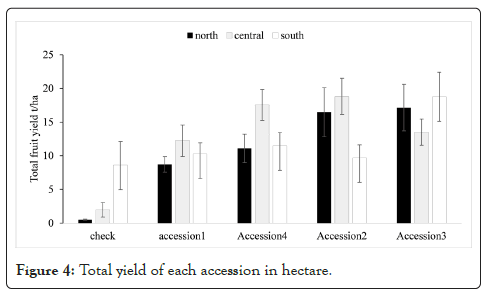
Figure 4: Total yield of each accession in hectare.
The results also showed that four landraces accessions persisted longer for more than 35.53 ± 1.81 days before deterioration than check that lasted for shorter 16.65 ± 0.36 days (Figure 5). The landraces showed physiological, agronomic and nutritional attributes that superseded improved tomato cultivar Tengeru 97 that was used as control in this experiment. All the four landrace accessions lasted longer in 20°C and below and remained firm throughout.
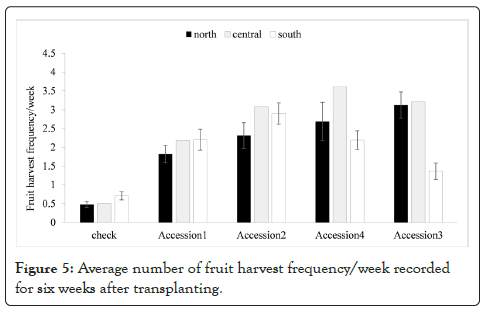
Figure 5: Average number of fruit harvest frequency/week recorded for six weeks after transplanting.
Number of leaves/plant
Number of leaves per plant is a determinant factor for growth and vigor. An increasing in number of plant can result into high yield. There was significant (F=23.67, df=4, p=<0.0001) variation in number of leaves/plant between tomato varieties. Landraces exhibited higher number of leaves than check in which accession 1 possessed significant highest number of leaves that averaged 29.04 ± 1.12 leaves/plant than accession 4 and check that possessed few leaves averaging 18.75 ± 0.62 leaves/plant shown in Figure 1.
Number of T. absoluta mines
T.absoluta larvae damage is determined by presence and incidence of larvae mines on leaves. Number of T.absoluta mines varied significantly (F=6.07, df=4, p=<0.0001) between tomato varieties in which landraces exhibited few mines compared to check that was more susceptive to larvae damage. Accession 3 exhibited significant low number of mines averaging 7.94 ± 0.74b per plants than control that possessed up an average of 12.98 ± 0.98 mines/plant shown in Figure 2.
Harvest frequency
There was significant variation (F=10.85, df=14, p=<0.0001) in harvest frequency between tomato variety and growing zones. Landrace accession possessed several harvest rates with short harvest intervals in which the central zone had more harvest frequency/ week than southern and northern zone. In central zone, accession 4 harvest frequency reached 3.61 ± 0.32/week than accession 3, 2, 1 and check, where the later only 0.5 ± 0.09 harvest/week was achieved. In northern zone accession 3 had more harvest frequency which averaged 3.12 ± 0.35 than accession 4, 2, 1 and check that had only 0.48 ± 0.08 frequency/week. The southern zone exhibited the lowest harvest frequency in which accession 2 had more harvest rate averaging 2.90 ± 0.21 than check that only 0.71 ± 0.10 harvest/ week was achieved shown in Figure 5.
Fruit damage/plant
Fruit damage by T.absoluta larvae is indicated by presence mines or pin holes on fruits. Variation of fruit damage/plant was significant (F=9.35, df=14, p=<0.0001) different between tomato varieties and zone where up to 118. 66 ± 21.18 g/plant was damaged due to T. absoluta larvae in check plants than in landrace accession 2, 1,4, and 3, the later exhibiting only 22.69 ± 3.23 g/plant in northern zone, followed by northern zone that averaged 66.44 ± 11.54 g/plant in check than 29.85 ± 4.01 in accession 4. The east-central zone exhibited the lowest damage but the check being most damaged with an average damage of 51.81 ± 5.00 g/plant than accession 2, 4, 3 and 1, the later with lowest damage that averaged 34.62 ± 4.44 g/plant shown in Figure 3.
Total yield t/ha
Effect of tomato variety on yield was significantly (F=5.2, df=14, p=<.0001) different between regions in which landrace accessions yielded more fruits (t/ha) than check in all zones. The east-central zone, yielded highest fruits than southern and northern where accession 2 yielded bulk fruits that averaged 18.82 ± 2.67 t/ha whereas check yielded only 1.96 ± 1.08 t/ha. In southern zone highest yield was achieved by accession 3 that averaged 18.82 ± 1.93 t/ha than check that yielded the lowest fruits that averaged 8.60 ± 3.50f t/ha. On other hand in northern zone accession 3 yielded the highest weight that averaged 17.15 ± 3.45 t/ha than accession 2,4, 1 and check that yielded lowest fruits averaging 0.51 ± 0.08 t/ ha shown in Figure 4.
Percentage of damaged tomato plot/ha
There was significant (F=20.02, df=14, p=<0.0001) effect of tomato accession and growing region in recording damage due to T.absoluta in which check plants in southern zone exhibited high damage and loss than landraces in northern and east central zone. The southern zone exhibited the lowest fruit damage where only 8.34 ± 1.35% of damage was recorded in accession 1 than check with highest damage which averaged 80.27 ± 12.14. In northern zone high yield loss due to T.absoluta damage reached 65.07 ± 11.46% in check than in accession 1 that averaged 9.54 ± 1.2% . On other hand, the central zone experienced low fruit damage in accession 1 that averaged 11.39 ± 1.24% damage of tomato check that exhibited 65.07 ± 11.46% damage (Figure 6).
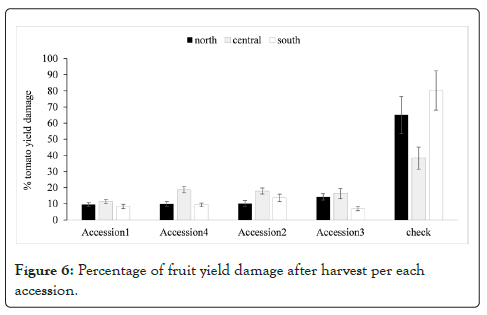
Figure 6: Percentage of fruit yield damage after harvest per each accession.
Post-harvest longevity and resilience
After harvest tomato fruits were place in laboratory room temperature for determination of longevity. Tomato landraces persisted longer before deterioration than check that lasted for only days. Color change and firmness was observed in which landraces retained firmness up to 20 days whereas check deteriorated in 14 days.
Landraces have additional physiological, agronomic and nutritional attributes that supersede improved tomato varieties [21]. All tomato landraces showed high resistance to T. absoluta damage by exhibiting lower number of larval amines and low amount of tomato fruit damage. This is because landraces produce chemical cues that are unattractive to T. absoluta for feeding and oviposition [7]. These indigenous cultivars have unique character such as high germination rate, early maturation and long harvest duration with attractive colour. They can strive under harsh conditions, and short harvest time as a result of higher yield that improved tomato variety. In this study neither pesticide nor fertilization was applied in plants to improve yield, yet landraces yielded more than improved variety that was high susceptible to damage by T. absoluta and other pests. Although landrace bear small fruits than improve varieties study showed that they can reside longer in room temperature before deterioration than improved cultivar. Despite the small size of landraces fruits, it can consumed entirely with its skin and seeds that reported to reserve high amount of nutrients including protein, vitamin C and phosphorus [16]. Landraces are reported to possess unique physiological, agronomic and nutritional attributes that supersede improved tomato varieties [21-24]. These indigenous cultivars showed unique characters such as high germination rate, early maturation and long harvest duration with attractive colour [19].
This study revealed that of all landraces performed better in East- central zone than in Southern and Northern zones it might be due to warm temperature from 25°C favouring tomato growth. Accession HSK-38 performed better by yielding more fruits in East-central zone with warm temperature than Northern and Southern zones that are chiller, but accession HSK-43 and KGM-5 lasted longer in 20°C and below showing that in cool temperature tomato can maintain quality than in warm temperature that accelerate microbial growth, contamination and produce decay. For economic and agricultural importance of tomato, accessions with early maturation, high yield, and high host defence trait, attractive and resilient fruits should be isolated and incorporated into tomato breeding program so as to improve production and income of small holder farmers in Tanzania.
First author extends her sincere appreciation to DAAD/ RUFORUM for supporting her PhD study. All authors are thankful to Mr. Maneno Chidege and Mr. Hamisy Mpina from Tropical Pesticides Research Institute (TPRI) for provision of seeds and technical support.
The author declares there is no conflict of interest.
Citation: Ndossi H, Zekeya N, Kiondo K, Abraham R, Mbega E (2021) Evaluation of Resilient Wild Tomato Accessions for Resistance against Tuta absoluta (Meyrick, 1917) in Tanzania. Entomol Ornithol Herpetol. 11: 267.
Received: 04-Jan-2022, Manuscript No. Eohcr-21-14759; Editor assigned: 10-Jan-2022, Pre QC No. Eohcr-21-14759 (PQ); Reviewed: 24-Jan-2022, QC No. Eohcr-21-14759; Revised: 28-Jan-2022, Manuscript No. Eohcr-21-14759; Published: 04-Feb-2022 , DOI: 10.35248/2161-0983.22.11.267
Copyright: © 2022 Ndossi H, et al. This is an open-access article distributed under the terms of the Creative Commons Attribution License, which permits unrestricted use, distribution, and reproduction in any medium, provided the original author and source are credited.